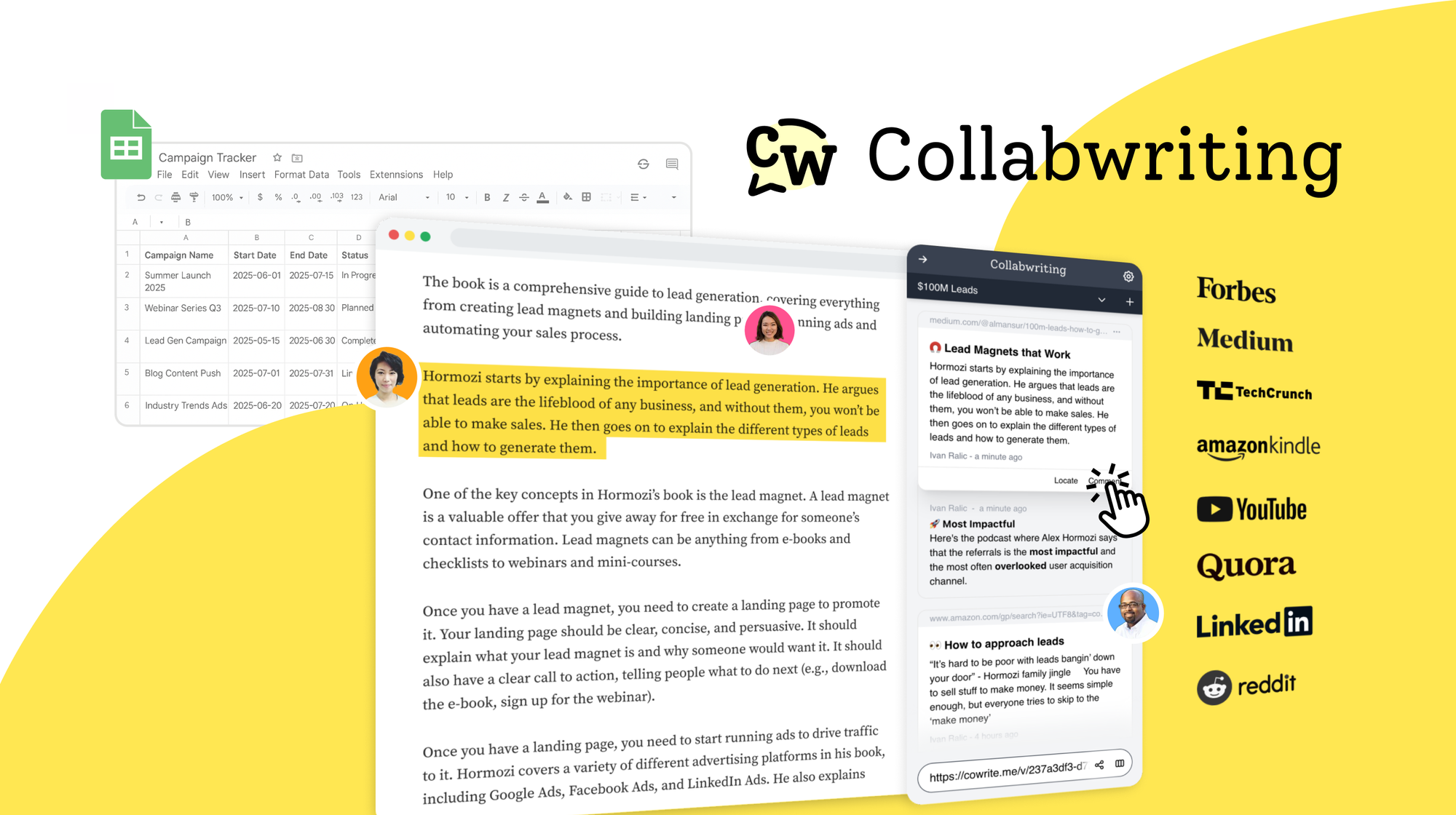Bookmarking tools are back, but not all are built for teams.
Collabwriting is built for team research: save articles, PDFs, YouTube videos, or social posts, highlight exact snippets, add comments, tags, and mentions, and keep context visible to everyone.
Raindrop: great for personal bookmarks and archiving, but collaboration is limited.
Bookmarking tools are making a quiet comeback. As we spend more time researching online, we need smarter ways to save, organize, and return to information without drowning in tabs or losing links in random docs.
Two tools stand out for people who take research seriously: Raindrop.io and Collabwriting. Both let you capture what you find online, but they’re built with very different goals in mind.
Let’s break down how they compare and which one makes more sense for collaborative research and annotation.
What This Article Covers:
- What Raindrop does well and where it falls short for teams.
- How Collabwriting offers a simpler, collaboration-first alternative.
- The key benefits and use cases for marketers, consultants, researchers, and other knowledge-driven teams.
What Raindrop.io Does Well
Raindrop.io is one of the most polished bookmarking apps available.
The team behind it positions Raindrop as “the best place to keep all your favorite books, songs, articles, or anything else you come across while browsing.”
With browser extensions, mobile apps, and plenty of integrations, you can quickly save any URL, PDF, or highlight. Once saved, you have multiple ways to keep things organized: folders, nested collections, tags, and even AI-powered sorting if you’re on the Premium plan.
- Bookmark everything, everywhere - With browser extensions, mobile apps, and integrations, you can quickly save any URL, PDF, or highlight.
- Organization options - Folders, nested collections, tags, and even AI-powered sorting (for Premium users).
- Search power - Premium unlocks full-text search across web pages, PDFs, and even EPUBs.
- Archiving - Saved pages are preserved as snapshots, so you don’t lose them even if the source disappears.
- Collaboration (basic) - You can share collections with others, useful for building a team library.
Raindrop shines if you want a personal bookmarking hub that’s well-organized and reliable. For solo researchers, it’s one of the best options out there.

But here’s the catch: Raindrop was designed as a bookmarking tool first. Collaboration is more of an add-on than the core of the product.
For individual use, Raindrop is one of the most powerful bookmarking apps available. But when research needs to be shared and discussed across a team, its limitations start to show.
Where Raindrop Falls Short for Teams
When teams work on research, they don’t just need a place to store links; they need a way to work with those links. That’s where Raindrop can feel limited:
- Shared collections are static - there’s no conversation happening inside them.
- Annotations are basic - you can highlight text, but adding context or discussing insights isn’t the focus.
- Organization can become overwhelming - folders, tags, and nested collections require ongoing effort.
- Search and archiving are locked behind Premium.
In short: Raindrop is great for saving information. But when it comes to turning saved content into shared knowledge, it leaves gaps.
How Collabwriting Approaches Research Collaboration Differently
Collabwriting starts from a different question: How can teams make sense of what they read online, together?
Instead of acting like a digital filing cabinet, it focuses on collaboration, context, and knowledge-building.
Here’s what sets Collabwriting apart:
- One-click saving - Like Raindrop, you can save articles, PDFs, YouTube videos, or social media posts (X, LinkedIn, Quora) in just one click.

- Precise snippets - Highlight the exact sentence or paragraph that matters, instead of saving an entire page (though you can still bookmark the whole page if you want).

- Context in comments & Slack integration - Every snippet can carry comments, tags, and mentions. Connected Slack workspaces allow you to mention teammates: type @, select the person, add your comment, and they receive an instant notification.
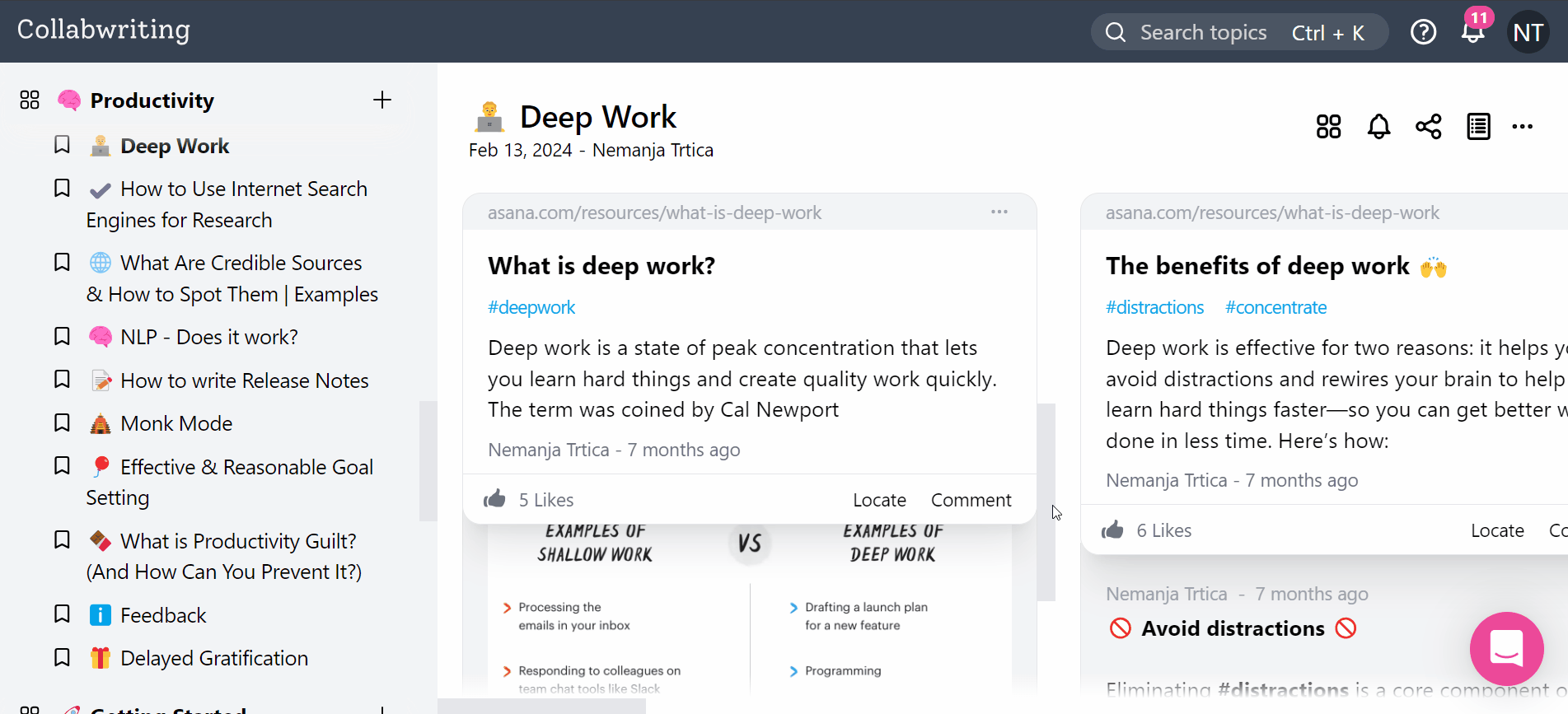
- Tagging & AI suggestions - Add custom tags to snippets, or let AI suggest relevant tags based on your previous research and the topic you’re working on.

- Clusters instead of folders - Organize content into flexible clusters (e.g., “Competitor Research” or “AI Trends”) without overthinking folder structures.
- Permissions for topics and clusters - Control who can view, edit, or comment on each topic or cluster, making team collaboration secure and organized.
- PDF collaboration – Work together on PDFs, whether they’re uploaded or online, with highlights, comments, and annotations visible to your team.
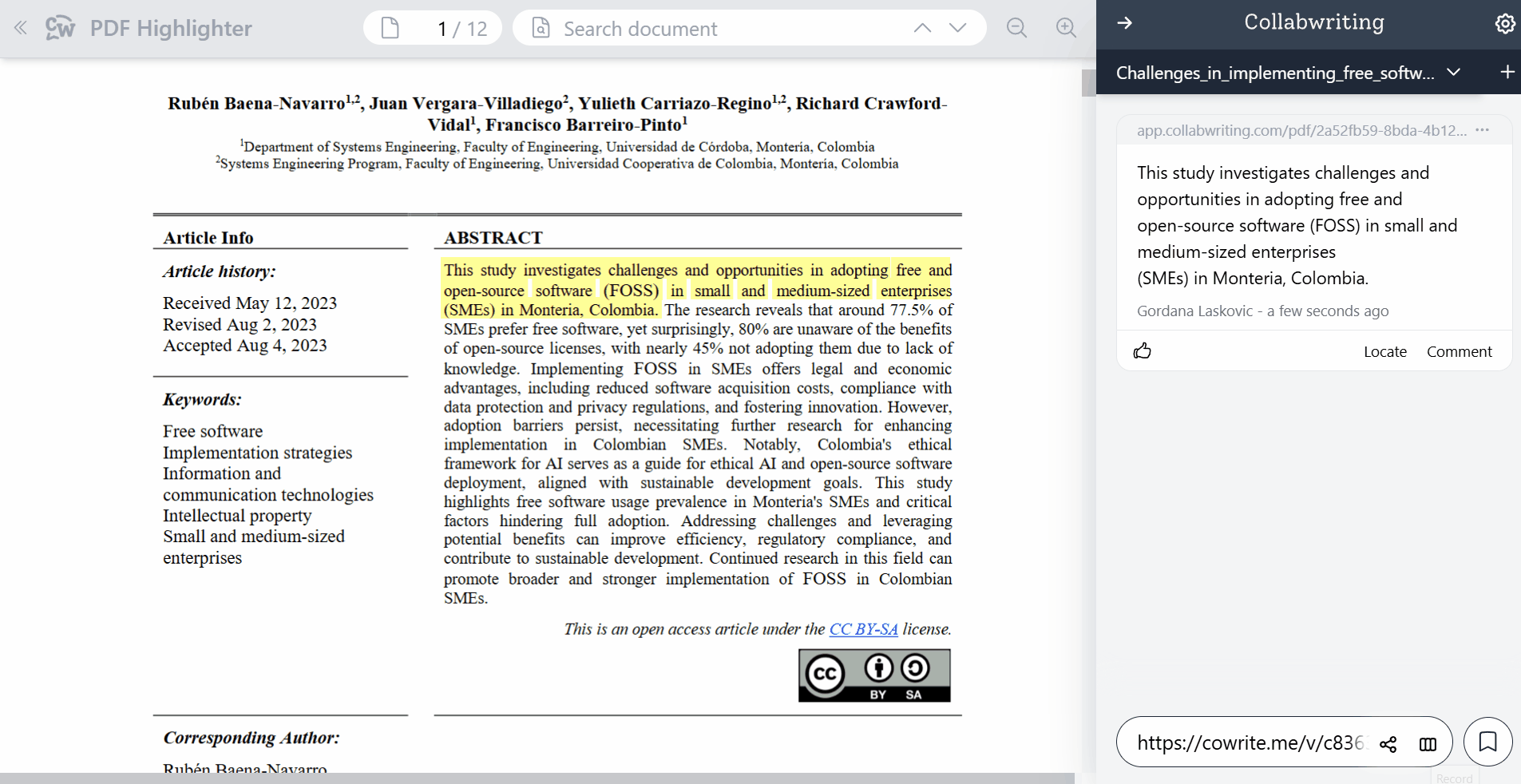
- Kindle integration - Save highlights and notes from your Kindle reading directly into your workspace.

- Traceability - Every snippet links back to its original source, so insights are always verifiable.
- Capture screenshots from YouTube - Grab visual content or key frames from videos to enrich your research.

- Team-first design - Collaboration isn’t an afterthought. Shared workspaces let everyone add, annotate, and discuss sources in one place.
- Chat your way to insights, then open them in Canvas for instant structure and clarity. 🔍
Collabwriting turns research into an ongoing conversation, not just a collection of links.
👉🏼 Nice ways you can use Collabwriting to make your life easier
Why Collabwriting is the Simpler Alternative to Raindrop
If you just want a personal bookmark manager, Raindrop is a strong choice. But for teams doing research, Collabwriting removes a lot of friction:
- No need to over-organize with tags and nested folders.
- No “context gap”. Everyone in a team instantly sees why a source matters.
- No extra tools (spreadsheets, Slack threads, Google Docs) to stitch the research process together.
With Collabwriting, you save, annotate, and collaborate in one flow.
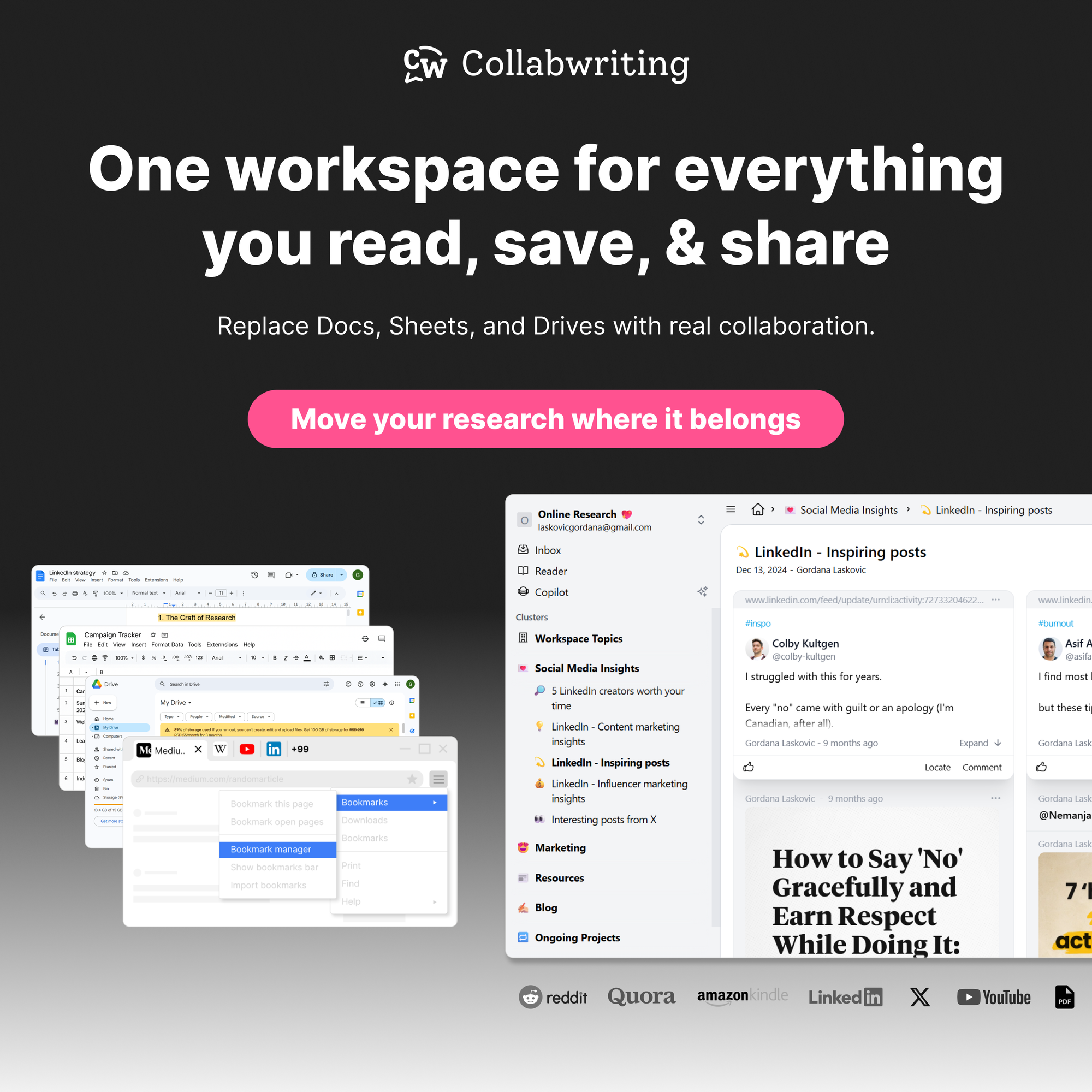
Collabwriting - Shareable Notes on Web Pages and PDFs
Collabwriting allows you to gather all your online sources in one place. No more endless scrolling, no more lost insights, just simple, structured knowledge at your fingertips.
Just highlight, save, and collaborate with anyone on any content you find online.
Why people love Collabwriting:
- Works with websites, PDFs, YouTube videos - all in one place
- Let's you leave comments, add tags, and mention anyone right on the snippet
- Organize research into clusters by client, topic, or project
- Share research with clients or stakeholders
- Export highlights and insights to Google Docs, Notion, Gmail, Outlook
- Import Kindle highlights directly into your research workspace
- Built for data privacy (ISO 27001 certified)
Which One Should You Choose: Collabwriting or Raindrop?
It all depends on what you need your research tool for. Are you focused on collaboration, tracking sources, and verifying insights, or are you mostly looking to create a personal collection of bookmarks?
- Choose Raindrop if you want a powerful personal bookmarking tool with advanced search and archiving.
- Choose Collabwriting if your goal is collaborative research and annotation, where shared context matters more than storage.
In a world where teams get lost in tabs, screenshots, and endless Google Docs, Collabwriting makes research simple and focused, helping teams turn information into actionable insights, together.
FAQ
What's the main difference between Raindrop and Collabwriting?
Raindrop is mainly a personal bookmarking tool with powerful search and archiving features. Collabwriting, on the other hand, is designed for team collaboration, letting you save, annotate, and discuss sources in one place while keeping context visible to everyone.
What's the main difference between Raindrop and Collabwriting?
Raindrop is mainly a personal bookmarking tool with powerful search and archiving features. Collabwriting, on the other hand, is designed for team collaboration, letting you save, annotate, and discuss sources in one place while keeping context visible to everyone.
Can I use Collabwriting just for myself?
Absolutely! While it shines in team settings, you can use Collabwriting as your personal research hub too.
Can I save social media posts or YouTube videos in Collabwriting?
Yes! With one click, you can save articles, PDFs, YouTube videos, and social media posts from X, LinkedIn, Reddit or Quora. You can also capture screenshots from videos for reference.
How does tagging work in Collabwriting?
You can manually add tags to snippets, and the AI can suggest relevant tags based on your previous research and the topic you’re working on. This keeps your content organized without extra effort.
Can I still bookmark full pages in Collabwriting?
Definitely! While precise snippets are great for context, you can also bookmark entire pages if you want to save everything.



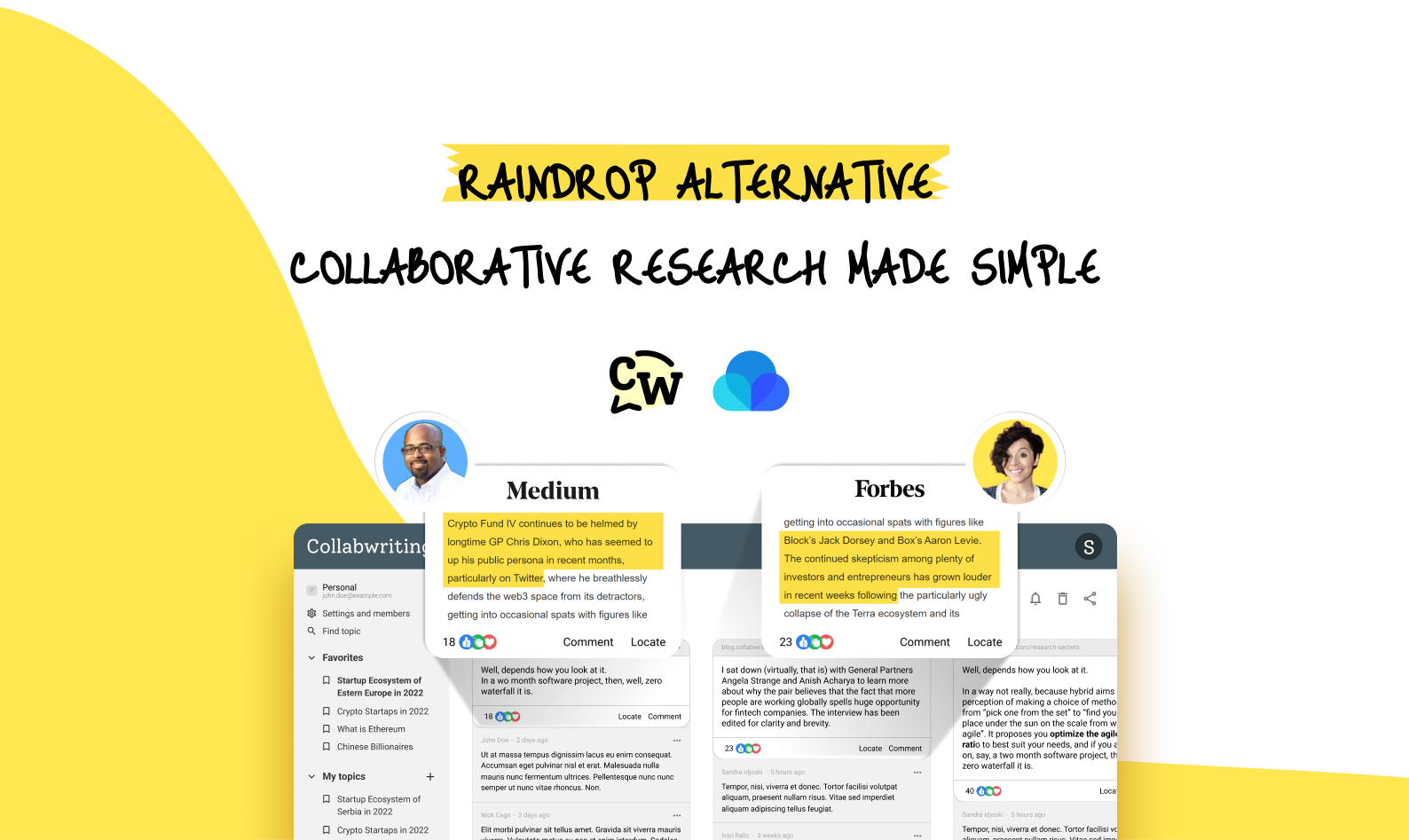
![The Best Tool for Collaborative Research in Content Marketing Teams [2026]](/content/images/2025/12/image--5-.png)

![5 Tools Marketers Use to Organize Research - Compared [2026]](/content/images/2025/11/cover-4-1.png)

![Build Credibility in Research: Smart Way to Verify Information and Track Sources Easily [2025]](/content/images/2025/10/covers-for-blog--7--1.png)
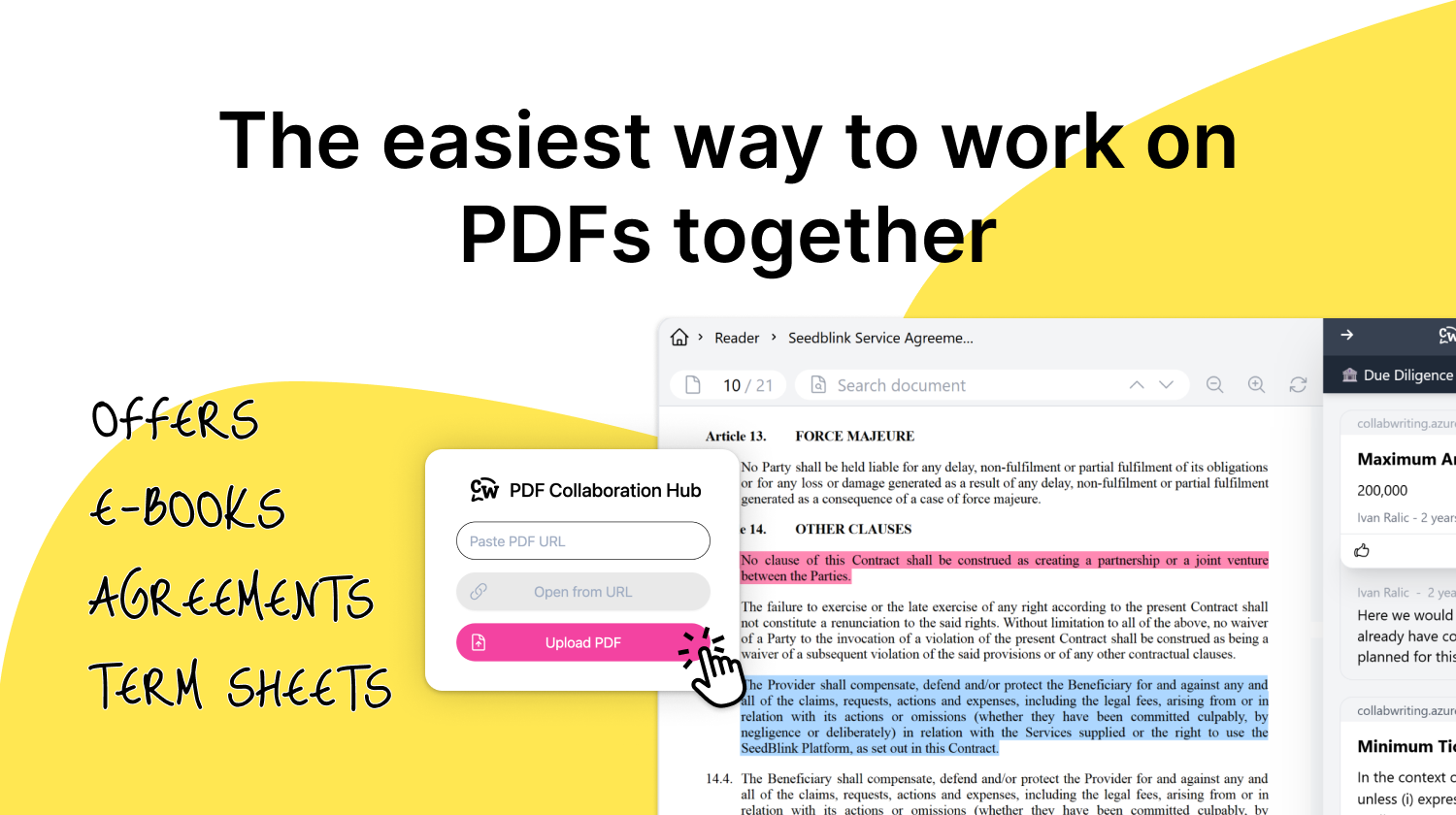
![How Marketers Can Turn LinkedIn Content into Collaborative Research [2025]](/content/images/2025/10/covers-for-blog--8-.png)
![Best Readwise Alternative for Personal & Team Research [2026]](/content/images/2025/09/Frame-814--3-.png)
